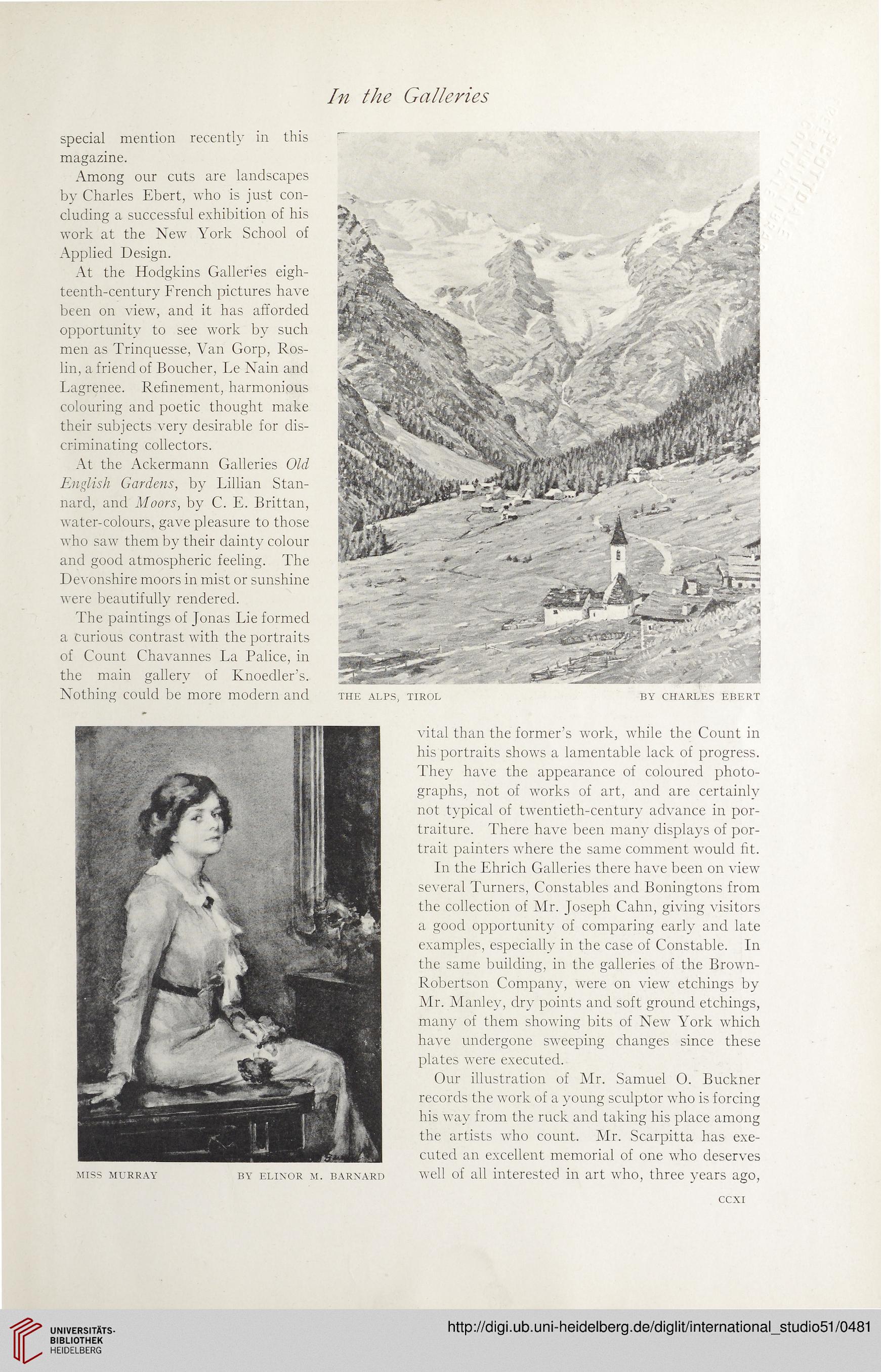In the Galleries
special mention recently in this
magazine.
Among our cuts are landscapes
by Charles Ebert, who is just con-
cluding a successful exhibition of his
work at the New York School of
Applied Design.
At the Hodgkins Galleries eigh-
teenth-century French pictures have
been on view, and it has afforded
opportunity to see work by such
men as Trinquesse, Van Gorp, Ros-
lin, a friend of Boucher, Le Nain and
Lagrenee. Refinement, harmonious
colouring and poetic thought make
their subjects very desirable for dis-
criminating collectors.
At the Ackermann Galleries Old
English Gardens, by Lillian Stan-
nard, and Moors, by C. E. Brittan,
water-colours, gave pleasure to those
who saw them by their dainty colour
and good atmospheric feeling. The
Devonshire moors in mist or sunshine
were beautifully rendered.
The paintings of Jonas Lie formed
a curious contrast with the portraits
of Count Chavannes La Palice, in
the main gallery of Knoedler’s.
Nothing could be more modern and
THE ALPS, TIROL BY CHARLES EBERT
MISS MURRAY BY ELINOR M. BARNARD
vital than the former’s work, while the Count in
his portraits shows a lamentable lack of progress.
They have the appearance of coloured photo-
graphs, not of works of art, and are certainly
not typical of twentieth-century advance in por-
traiture. There have been many displays of por-
trait painters where the same comment would fit.
In the Ehrich Galleries there have been on view
several Turners, Constables and Boningtons from
the collection of Mr. Joseph Cahn, giving visitors
a good opportunity of comparing early and late
examples, especially in the case of Constable. In
the same building, in the galleries of the Brown-
Robertson Company, were on view etchings by
Mr. Manley, dry points and soft ground etchings,
many of them showing bits of New York which
have undergone sweeping changes since these
plates were executed.
Our illustration of Mr. Samuel O. Buckner
records the work of a young sculptor who is forcing
his way from the ruck and taking his place among
the artists who count. Mr. Scarpitta has exe-
cuted an excellent memorial of one who deserves
well of all interested in art who, three years ago,
ccxi
special mention recently in this
magazine.
Among our cuts are landscapes
by Charles Ebert, who is just con-
cluding a successful exhibition of his
work at the New York School of
Applied Design.
At the Hodgkins Galleries eigh-
teenth-century French pictures have
been on view, and it has afforded
opportunity to see work by such
men as Trinquesse, Van Gorp, Ros-
lin, a friend of Boucher, Le Nain and
Lagrenee. Refinement, harmonious
colouring and poetic thought make
their subjects very desirable for dis-
criminating collectors.
At the Ackermann Galleries Old
English Gardens, by Lillian Stan-
nard, and Moors, by C. E. Brittan,
water-colours, gave pleasure to those
who saw them by their dainty colour
and good atmospheric feeling. The
Devonshire moors in mist or sunshine
were beautifully rendered.
The paintings of Jonas Lie formed
a curious contrast with the portraits
of Count Chavannes La Palice, in
the main gallery of Knoedler’s.
Nothing could be more modern and
THE ALPS, TIROL BY CHARLES EBERT
MISS MURRAY BY ELINOR M. BARNARD
vital than the former’s work, while the Count in
his portraits shows a lamentable lack of progress.
They have the appearance of coloured photo-
graphs, not of works of art, and are certainly
not typical of twentieth-century advance in por-
traiture. There have been many displays of por-
trait painters where the same comment would fit.
In the Ehrich Galleries there have been on view
several Turners, Constables and Boningtons from
the collection of Mr. Joseph Cahn, giving visitors
a good opportunity of comparing early and late
examples, especially in the case of Constable. In
the same building, in the galleries of the Brown-
Robertson Company, were on view etchings by
Mr. Manley, dry points and soft ground etchings,
many of them showing bits of New York which
have undergone sweeping changes since these
plates were executed.
Our illustration of Mr. Samuel O. Buckner
records the work of a young sculptor who is forcing
his way from the ruck and taking his place among
the artists who count. Mr. Scarpitta has exe-
cuted an excellent memorial of one who deserves
well of all interested in art who, three years ago,
ccxi




